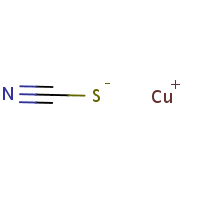Cuprous thiocyanate
Agent Name
Cuprous thiocyanate
CAS Number
1111-67-7
Formula
C-H-N-S.Cu
Major Category
Metals

Synonyms
Copper thiocyanate; Copper(1+) thiocyanate; Thiocyanic acid, copper(1+) salt; [ChemIDplus] Cuprous sulfocyanate; Copper monothiocyanate; [Merck Index] Copper (I) thiocyanate; [ECHA - Proposal for Harmonised Classification and Labelling] UN3077
Category
Metals, Inorganic Compounds
Description
White to yellow solid; [Merck Index] White-gray odorless solid; [ECHA - Proposal for Harmonised Classification and Labelling] Powder; [Sigma-Aldrich MSDS]
Sources/Uses
Used in marine antifouling paints and primers for explosives; [Merck Index]
Comments
Not a skin or eye irritant in rabbits; Not sensitizing in guinea pig maximization study; [ECHA - Proposal for Harmonised Classification and Labelling] May cause irritation; Harmful by ingestion and skin absorption; Toxic by inhalation; [Sigma-Aldrich MSDS] See "Potassium thiocyanate" and "Sodium thiocyanate." See "Copper(II) acetate."
Biomedical References
Exposure Assessment
TLV (ACGIH)
1 mg/m3, as Cu
PEL (OSHA)
1 mg/m3, as Cu
MAK
0.01 mg/m3, respirable fraction (Cu, inorganic cmpnds)
IDLH (NIOSH)
100 mg/m3, as Cu
Lethal Concentration
LC50 (rat) > 5,860 mg/m3/4hr
Explanatory Notes
The Guide in the Emergency Response Guidebook is for "Environmentally hazardous substances, solid, n.o.s."
Adverse Effects
Methemoglobinemia
MetHgb is secondary toxic effect
Neurotoxin
Other CNS neurotoxin
Hepatotoxin
Hepatoxic (a) from occupational exposure (secondary effect) or (b) in animal studies or in humans after ingestion
Diseases, Processes, and Activities Linked to This Agent
Processes
Industrial Processes with risk of exposure: